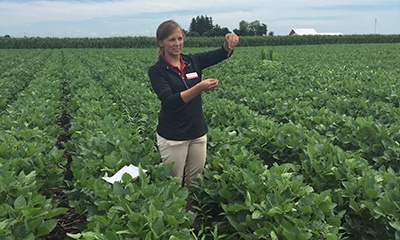
Farmers, crop consultants, agronomists and others interested in weed management issues attended the 2016 “Weeds Week” events July 18-22 across Iowa. Sponsored by Iowa State University Extension, a workshop was held each day at one of the five different locations. This was the program’s second year.

APPLICATION TIMING: At the Weeds Week session at Crawfordsville, ISU Extension agronomist Meaghan Anderson discussed the importance of timing and weed size in relation to making herbicide applications.
“We had two main goals with this year’s workshops,” says Virgil Schmitt, an ISU Extension field agronomist and coordinator of Weeds Week. “First, we provided some insight and help for people who are experiencing herbicide resistant weeds in their fields. But more importantly, we helped them create a weed management program so they don’t incur weed resistance in the first place. It’s much cheaper to prevent weed resistance than it is to deal with it after you have it in your field.”
Address herbicide resistance, manage resistant weeds
Two of Schmitt’s ISU Extension colleagues, field agronomists Rebecca Vittetoe and Meaghan Andersen, helped with the Weeds Week workshop at Crawfordsville in southeast Iowa. Other ISU agronomists located around the state presented information at the other four workshops in their areas: at Sutherland, Nashua, Boone and Lewis.
Vittetoe provides the following report explaining what attendees learned at the 2016 Weeds Week workshops. Be sure to read her column in the upcoming August issue of Wallaces Farmer magazine.
Cheaper to prevent resistance than to deal with it later
Using herbicides to manage weeds is a relatively simple system. It provides farmers with more time to manage weeds, less soil disturbance, and a high efficacy against target weeds. This system is also relatively simple for weeds to overcome with resistance, and weed resistance to herbicides comes with a big price tag.
Herbicide resistance costs farmers $20 to $60 or more per acre according to a recent study conducted by USDA’s Economic Research Service. (See ers.usda.gov).
Once weed resistance occurs, it’ll likely stay in the field forever. That’s why the cost of diversifying weed management programs to prevent resistance is more economical than managing resistant weeds with fewer herbicide options. Once weed resistance occurs, it will likely remain in a field forever.
What causes weed resistance to herbicides?
Herbicides have not caused weed resistance issues, contrary to what some may think. Rather, there are natural mutants in a weed population that carry a gene making that weed resistant to the herbicide product being applied. With repeated use of a single herbicide group, selection pressure is put on the weed population for the mutant weed with resistance to persist and multiply. It doesn’t matter what specific herbicide product is used. If the same product is used repeatedly, resistance will develop.
Steps you should take to prevent herbicide resistance
1) Know your enemy. What are the problem weeds on your farm? Knowing what weed spectrum you are dealing with can help you tailor a herbicide program to work well against your problem weeds.
2) Understand difference between herbicide mode of action and site of action There is often confusion about the difference between “Mode of Action” (MOA) and “Site of Action” (SOA). Many people use these terms interchangeably. It is very important to differentiate between the two terms
The MOA of a herbicide refers to the effect the herbicide has on plant growth. The site of action refers to the specific location within the plant that the herbicide binds to. SOA are subsets of MOA and are also referred to as herbicide groups. Two herbicides with different herbicide groups will bind to different locations to kill a plant. Knowing the herbicide group (SOA) is critical to using effective products and designing a resilient herbicide program. It is much easier for farmers now that most herbicide labels list the herbicide group on the front page.
* Use multiple and effective sites of action. The next step is to use multiple herbicide groups that are effective against your target weeds to delay or prevent resistance development.
Another part of using effective sites of action is using effective herbicide rates. This requires taking a look at how much of the actual active ingredient is included in a herbicide product.
* Timing is also a critical component. Newly germinating or small weeds are significantly easier to kill than weeds over 6 inches in height. Part of the timing component is not relying on just one herbicide application.
Start off with a weed-free seedbed in spring by using tillage or an appropriate burndown application. Next, apply a full-rate of an effective preemergence herbicide as close to final seedbed preparation as possible—followed by a timely postemergence herbicide application. Layering a residual herbicide with the postemergence herbicide application is a way to provide longer management of late-germinating weeds, like waterhemp. This can be especially effective with Group 15 herbicide products because of their relatively short residuals.
* Integrate other weed control tactics into your weed management plan. Looking ahead, the likelihood of a new herbicide group entering the market in the near future is very slim, which means our options are likely limited to the herbicide groups that are available today.
We need to be hands-on with weed management, whether managing existing resistances or preventing new resistances from becoming a problem. Other weed management tactics, like increasing crop competitiveness, using crop rotation and mechanical weed management will be important to supplement chemical tactics to prevent the complete breakdown of the usefulness of herbicides.
Putting all of these pieces together to develop a long-term weed management plan requires asking the right questions to determine what is right for your farm this year. This is not necessarily the same thing that was right for your farm or field last year or is right for your neighbor’s field. There is no one silver bullet when it comes to weed management.
Here are some resources you may find helpful in putting together a weed management program:
•2016 Herbicide Guide for Iowa Corn and Soybean Production: store.extension.iastate.edu/Product/2016-Herbicide-Guide-for-Iowa-Corn-and-Soybean-Production
•Iowa State Weed Science website: weeds.iastate.edu/
•Take Action on Weeds website: takeactiononweeds.com/
•Contact your local ISU Extension field agronomist.
Rebecca Vittetoe is an ISU Extension field agronomist covering southeast/south central Iowa. Contact her at [email protected].
About the Author(s)
You May Also Like




